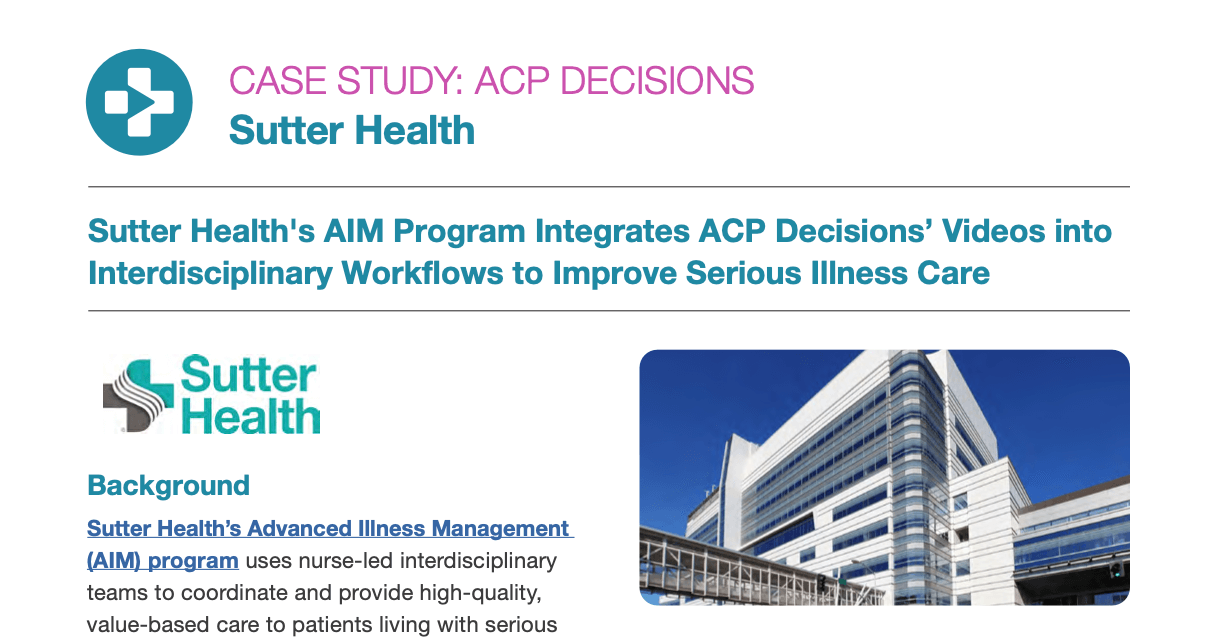IMPLEMENTATION | May 26, 2018
4 Best Practices for Effective Shared Decision Making
Reading Time: 3 minutes

Most of us live in a world full of choices – ranging from the most mundane to complex, life-changing decisions. Undoubtedly, healthcare decisions are among the most significant we may make at some point. Often, when the time comes to make important medical decisions, many people are overwhelmed and unable to fully comprehend all their options.
While the majority of patients desire to have their healthcare providers share the best information available to help them make treatment decisions, wide discrepancies exist between what patients want and how medical decisions are made.
Shared decision making (SDM) can help bridge the gap between the care patients want and the care they receive. The Agency for Healthcare Research and Quality (AHRQ) defines SDM as open communication between the patient and the provider, who work together to determine a care or treatment plan that outlines the risks and benefits while balancing patient values, preferences, and medical best practices.
While evidence has shown that SDM improves patient outcomes, supports patient engagement and results in care that is aligned with patient preferences, the practice is still elusive in many healthcare encounters. Here are four best practices to promote effective shared decision making.
Assess & address patient values, preferred language, and health literacy levels

Health literacy status affects patients’ ability to utilize health information and services, which impacts health outcomes. Values vary by culture and have a considerable influence on patient preferences for care. Additionally, it is important to identify preferred language use for effective communication. Patients will be empowered to be more involved in treatment decisions through SDM when their values, language, and health literacy needs are addressed through culturally and linguistically appropriate educational materials that are at an appropriate literacy level.
Practice active collaboration

SDM is more than just making decisions about care – it is a process, a conversation, a path to determining the best care for an individual. The goal of patient-provider collaboration is to select evidence-based medical care that fits an individual’s values and preferences. Determining the best path of treatment requires collaboration between the patient, provider and often, family and caregiver. During the collaborative process, a clinician introduces options, helps patients explore preferences, guides decisions and involves family members and caregivers where appropriate. An open dialogue between patients and their providers results in better compliance and outcomes.
Use evidence-based educational resources and decision aids

Patient decision aids facilitate patient engagement and encourage more involvement in treatment decisions. The International Patient Decision Aids Standards (IPDAS) Collaboration recommends using high-quality, unbiased and evidence-based patient decision aids to help patients obtain information on decision options. Decision aids may include printed booklets, videos, or web-based resources designed to help patients and their families and caregivers participate in SDM. These tools can help patients clarify and communicate their personal values to their providers by providing them with information on the risks, benefits, challenges and alternatives to care options.
Streamline the SDM process into daily workflow

Embedding SDM into clinical workflows ensures the process is integrated into care delivery. Using Health IT systems, such as EHRs, to identify situations in which SDM should occur and to simplify documentation and access to tools, will galvanize the process. Some examples include:
- Flagging patients with specific situations or conditions to trigger a conversation
- Providing access to standard SDM tools focused on end-of-life care options to support advance directive documentation
- Offering the ability to prescribe patient decision aids to patients via the EHR
- Delivering prompts to access a relevant patient decision aid
Shared decision making drives patient-centered care that is aligned with patient preferences. Employing these four best practices will enable healthcare providers to engage in effective SDM with their patients.
ACP Decisions creates evidence-based video decision aids that empower patients and healthcare providers to engage in shared decision making. Our advance care planning videos are patient-centered and designed to help patients optimally navigate their healthcare. To learn more please visit www.acpdecisions.org.
You might also like...

Sutter Health’s AIM Program Integrates ACP...
CASE STUDIES, IMPLEMENTATION | < 1 MIN READ


